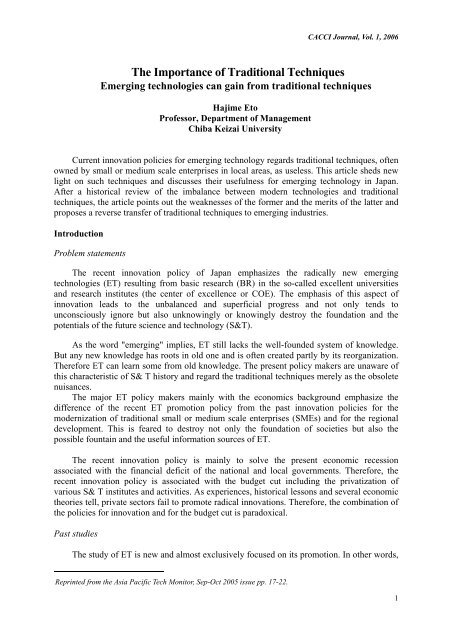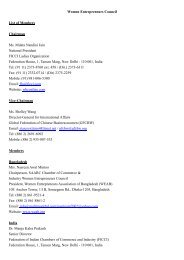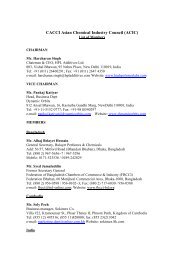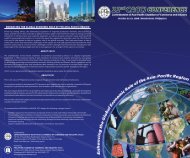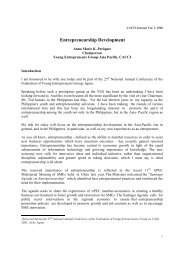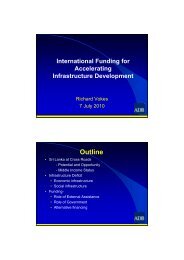The Importance of Traditional Techniques - cacci
The Importance of Traditional Techniques - cacci
The Importance of Traditional Techniques - cacci
Create successful ePaper yourself
Turn your PDF publications into a flip-book with our unique Google optimized e-Paper software.
CACCI Journal, Vol. 1, 2006<strong>The</strong> <strong>Importance</strong> <strong>of</strong> <strong>Traditional</strong> <strong>Techniques</strong>Emerging technologies can gain from traditional techniquesHajime EtoPr<strong>of</strong>essor, Department <strong>of</strong> ManagementChiba Keizai UniversityCurrent innovation policies for emerging technology regards traditional techniques, <strong>of</strong>tenowned by small or medium scale enterprises in local areas, as useless. This article sheds newlight on such techniques and discusses their usefulness for emerging technology in Japan.After a historical review <strong>of</strong> the imbalance between modern technologies and traditionaltechniques, the article points out the weaknesses <strong>of</strong> the former and the merits <strong>of</strong> the latter andproposes a reverse transfer <strong>of</strong> traditional techniques to emerging industries.IntroductionProblem statements<strong>The</strong> recent innovation policy <strong>of</strong> Japan emphasizes the radically new emergingtechnologies (ET) resulting from basic research (BR) in the so-called excellent universitiesand research institutes (the center <strong>of</strong> excellence or COE). <strong>The</strong> emphasis <strong>of</strong> this aspect <strong>of</strong>innovation leads to the unbalanced and superficial progress and not only tends tounconsciously ignore but also unknowingly or knowingly destroy the foundation and thepotentials <strong>of</strong> the future science and technology (S&T).As the word "emerging" implies, ET still lacks the well-founded system <strong>of</strong> knowledge.But any new knowledge has roots in old one and is <strong>of</strong>ten created partly by its reorganization.<strong>The</strong>refore ET can learn some from old knowledge. <strong>The</strong> present policy makers are unaware <strong>of</strong>this characteristic <strong>of</strong> S& T history and regard the traditional techniques merely as the obsoletenuisances.<strong>The</strong> major ET policy makers mainly with the economics background emphasize thedifference <strong>of</strong> the recent ET promotion policy from the past innovation policies for themodernization <strong>of</strong> traditional small or medium scale enterprises (SMEs) and for the regionaldevelopment. This is feared to destroy not only the foundation <strong>of</strong> societies but also thepossible fountain and the useful information sources <strong>of</strong> ET.<strong>The</strong> recent innovation policy is mainly to solve the present economic recessionassociated with the financial deficit <strong>of</strong> the national and local governments. <strong>The</strong>refore, therecent innovation policy is associated with the budget cut including the privatization <strong>of</strong>various S& T institutes and activities. As experiences, historical lessons and several economictheories tell, private sectors fail to promote radical innovations. <strong>The</strong>refore, the combination <strong>of</strong>the policies for innovation and for the budget cut is paradoxical.Past studies<strong>The</strong> study <strong>of</strong> ET is new and almost exclusively focused on its promotion. In other words,Reprinted from the Asia Pacific Tech Monitor, Sep-Oct 2005 issue pp. 17-22.1
CACCI Journal, Vol. 1, 2006it is concentrated on ET itself. Many studies <strong>of</strong> ET policies not only ignore but also deny theusefulness <strong>of</strong> traditional techniques and even blame past policies as having inspired localSMEs to stick to obsolete techniques. <strong>The</strong>refore, almost no study has been made abouttraditional techniques working in tandem with ETs. Because <strong>of</strong> the absence <strong>of</strong> relevant Japanesecase studies, this article is based on my own past studies.Plan <strong>of</strong> this articleThis article discusses the role <strong>of</strong> traditional techniques in the era <strong>of</strong> ET in Japan. Section2 historically reviews the imbalance (and the resulting dual structures) between modernizedand underdeveloped technologies that have resulted from rapid innovation in Japan in thepast. 1,2 Section 3 discusses the dilemmas <strong>of</strong> recent innovation policies with respect to thesedual structures and the weaknesses <strong>of</strong> recently developed ETs in comparison to traditionaltechniques. 3,4 Section 4 presents proposals to solve the resulting problems.Dual structures in the pastResult <strong>of</strong> rapid catch-up policiesIn the late 19th century, the government <strong>of</strong> Japan sought rapid modernization to rivalWestern powers in military aspects. For this purpose, the government promoted moderntechnologies for munitions <strong>of</strong> war, such as steel production and shipbuilding, leaving other industriesat underdeveloped levels.At first, Japan exported agricultural products, such as raw silk, and handicrafts, such asdolls.In the early 20th century, the spinning industry was highly developed in Japan and filledthe gap after England retreated from Asian markets such as India and China. This acceleratedthe development <strong>of</strong> looms. S. Toyota invented a series <strong>of</strong> automatic looms and raised theproductivity <strong>of</strong> the spinning industry <strong>of</strong> Japan over its English rivals. Thus, in the pre-warperiod, the military and spinning technologies <strong>of</strong> Japan achieved top world levels, while othertechnologies were left underdeveloped.But the development <strong>of</strong> looms stimulated the development <strong>of</strong> machinery in general. <strong>The</strong>army promoted the conversion <strong>of</strong> loom technologies to automobile technologies. Supportedby the army, Nissan and Toyota began production <strong>of</strong> trucks and motor cars in the 1930s, butthe technologies for comfortable passenger cars remained underdeveloped.A similar imbalance was seen in electric technologies. Technologies for powergenerators and military communication equipment were developed, while technologies forhome electrical appliances remained underdeveloped.In the USSR, J. Stalin launched the first five-year plan in 1928. This plan hoped todevelop the entire economy through a pull effect from the heavy and chemical industries.Indeed, the products <strong>of</strong> the heavy and chemical industries helped light industries by providingmachine tools, high quality materials and the like. It also helped agriculture by providingtractors, agricultural chemicals and others.2
CACCI Journal, Vol. 1, 2006Policies in the 20 th centuryIn 1972, K. Tanaka was nominated as Prime Minister. He was the first prime ministerfrom the "backside <strong>of</strong> Japan" and made a radical innovation in innovation policies. His ideawas to promote local economies by relocating heavy industries to local areas. As bigenterprises had modern technologies, relocating their factories could be expected to stimulatelocal SM Es to raise their technology levels. But strong urban criticism and the oil crisis <strong>of</strong>1973 hindered his plan. He did, however, have a strong impact on regional developmentpolicies.Severe pollution problems moved local residents to invite only "clean" high-tech industries,such as information technology (IT) industries. In the 1970s and 1980s, the central governmentencouraged local governments to construct science-based high-tech industry districts, calledscience parks, techno-parks or academia parks. Nearly 100 science parks were constructed inevery part <strong>of</strong> Japan. At the same time, local governments invested in research and development(R&D), which attracted public attention. <strong>The</strong> central government's White Paper on S& Twelcomed local R&D. In the beginning <strong>of</strong> the 1990s, however, recession hit the Japaneseeconomy and gave rise to financial deficits in the public sector as well as in the private sector.Industrial R&D expenditure decreased and few industries came to science parks, which remainvacant even today.Around 2000, the central government made the second radical innovation in innovationpolicies, shifting from the promotion <strong>of</strong> big enterprises to the promotion <strong>of</strong> small ventures andfrom regional development back to promotion <strong>of</strong> ETs in urban areas. This shift is discussedbelow.High-tech to ETChange in definition<strong>The</strong> industrial policy from the Korean War to the 1990s had been to rebuild and grow theheavy and chemical industries, and through them to lead a total economic development, asStalin had earlier conceived for the USSR. Sut this idea was no longer regarded as effective.Indeed, N. Khrushchev shifted Stalin's policy to the promotion <strong>of</strong> ETs such as spacedevelopment. Under John F. Kennedy, the USA too followed this policy.<strong>The</strong> USSR and the USA spent a great amount <strong>of</strong> resources on ETs, which gave noimmediate returns in economic terms. In the meantime, Japan continued to develop the heavyand chemical technologies and achieved world leadership in cars, TV sets, IC chips, carbonproducts and others. Japan called such technologies high-tech and was satisfied with them,even though its s<strong>of</strong>tware technologies were at a relatively low level.After the demise <strong>of</strong> the USSR, however, US industries shifted emphasis from military toindustrial technologies and began to excel Japan in the latter. In particular, US research inDNA and bio-technology is far above its Japanese counterpart. Simultaneously, Japanesehigh-tech began to lose competitively in the world market. Today, indeed, many Asiancountries are strong competitors <strong>of</strong> Japan not only in steel and cars but also in electronics ands<strong>of</strong>tware.4
CACCI Journal, Vol. 1, 2006Like many other countries, Japan still retains its own traditional management styles thateffectively work in Japanese enterprises, especially in local SMEs. Indeed, the so-called Japanesemanagement, universally praised in the 1970s and 1980s, exploited the characteristics <strong>of</strong>Japanese business practices. <strong>The</strong> globally acclaimed Japanese management was unique in thesense that the management styles in local SMEs and even those <strong>of</strong> big enterprises in head<strong>of</strong>fices and sales shops were behind the modernization <strong>of</strong> the 1960s and 70s. All big enterprises<strong>of</strong> Japan modernized production lines and sent their engineers abroad to learn frontiertechnologies. Thus the big enterprises <strong>of</strong> Japan attained top efficiency in production lines inthe mid-1960s. Even so, head <strong>of</strong>fices rejected the rationalization and retained traditionalmanagement styles, even in big enterprises. In some ways, this is what was praised asJapanese management.<strong>The</strong> globalization <strong>of</strong> the 1990s extinguished Japanese management systems in largeenterprises. But they are still alive in SMEs in general and local ones in particular. A carefulobservation and analysis <strong>of</strong> these surviving management systems can be expected to help thedevelopment <strong>of</strong> new types <strong>of</strong> business applicationware and business models. <strong>The</strong> "obsolete"local SMEs with traditional management systems can be key developers <strong>of</strong> new IT products.In contrast with the weakness in s<strong>of</strong>tware in general, Japan is strong in game s<strong>of</strong>tware forgeneral users. Among others, one reason may be the absence <strong>of</strong> a specialized pr<strong>of</strong>essionalmarket in sophisticated military game s<strong>of</strong>tware for political reasons. <strong>The</strong> absence <strong>of</strong> demandfor real war games or simulations has driven s<strong>of</strong>tware makers toward game s<strong>of</strong>tware for generalusers.Another reason may be the survival or presence <strong>of</strong> typical Japanese games, which haveprovided the seeds <strong>of</strong> new ideas for games. Go originally came from China and has beenhighly developed in Japan. <strong>The</strong> shag; <strong>of</strong> Japan was originally from Chinese chess but hasbeen revised in Japan. <strong>The</strong> Chinese-origin mah-jongg has been very popular amongbusinessmen and government <strong>of</strong>ficers. Besides these games, local areas retain a variety <strong>of</strong>traditional games as their "niches". A collection <strong>of</strong> such games may be expected to provideseeds for the development <strong>of</strong> new game s<strong>of</strong>tware. Local SMEs are well placed for suchdevelopment.Database <strong>of</strong> traditional techniques<strong>The</strong> Agency <strong>of</strong> Culture (part <strong>of</strong> the Ministry <strong>of</strong> Education) and NHK (the nationalbroadcasting corporation) have taken pictures <strong>of</strong> local customs, such as traditional festivals,traditional foods, folk dances and others for permanent record. This is extremely valuablefrom sociological and anthropological points <strong>of</strong> view.A similar project may be proposed to record traditional techniques, includingmanagement practices, in the form <strong>of</strong> sound, images, written documents and others. Moderntechnologies will find new seeds in these records.Local museums have collected the "ruins and fossils" <strong>of</strong> old tools, products, pictures andothers, some <strong>of</strong> which are related with traditional techniques in the areas. Indeed, local museumsdisplay the tools for wine (sake) fermentation in the areas. Local libraries have alsocollected documents and pictures <strong>of</strong> such things. Similar activities are seen for botanical orzoological gardens, aquariums and the likes. A salmon-fishing village operates an aquarium8
CACCI Journal, Vol. 1, 2006specializing in salmon and collects many salmon-related species. Further it collects old toolsfor salmon fishing and old documents about the salmon fishing system. <strong>The</strong> collection isvaluable in biological and sociological aspects. Anther fishing village operates an aquarium <strong>of</strong>sardines, a third operates an aquarium <strong>of</strong> shellfish, and so on. But these collections are "randomly"dispersed in various areas and are not systematized at present. <strong>The</strong>refore, the retrieval<strong>of</strong> the information collected is not easy. Systematic catalogues may be needed.Museums, libraries, botanical or zoological gardens, aquariums and similar institutes(simply "museums" hereafter) are in financial difficulties and some are now closed. Nationaland local governments recently privatized museums or suspended financial support to them.This is mainly because policy makers with legal or economic backgrounds are ignorant <strong>of</strong> thescientific tasks <strong>of</strong> these museums. Such policy-makers misunderstand museums merely asshowrooms to amuse children and do not know what is done behind the showrooms. It isurgent to make government people more literate about S& T and culture, besides politics andeconomies.Policy makers remember museums as "hells" in their childhood. <strong>The</strong>y remember thattheir teachers forced them to visit the "hells" and to write reports on the assigned topics. This"bad memory" drives them to make policies to lead to their closing the "hells". Museums arestill open by saving costs by, for example, discarding some <strong>of</strong> the collected items.In fact, many zoos discard animals unique to the local areas as unattractive and insteadare now training pandas for walking on two hind legs in order to attract visitors and gainadmission fees. This concentration on particular species, I fear, will make systematiczoological research difficult. Indeed, this has disappointed local amateur zoologists andschoolteachers. Unaware <strong>of</strong> scientific and education methodologies, such as taxonomy, policymakers are interested only in the panda and other popular animals. Unlike the policy makers,however, some children and parents are interested in obtaining scientific or historicalknowledge in the museums. Such a learning attitude is the fountain <strong>of</strong> future S& T andculture.<strong>The</strong> financial deficit has driven governments to cut the budget for elementary schoolsand now to drain the S& T fountain.Conclusion<strong>The</strong> discussions above present the merits <strong>of</strong> traditional techniques that are expected to beuseful to ETs. <strong>The</strong> recently formed cooperative unions <strong>of</strong> enterprises and universities wouldbe well advised to transfer traditional techniques to universities and high-tech big enterprisesfor filling deficiencies in ET. <strong>The</strong> creation <strong>of</strong> a knowledge database <strong>of</strong> traditional techniquesand the systematization <strong>of</strong> catalogues <strong>of</strong> techniques collected in dispersed museums areadvisable for easy retrieval <strong>of</strong> valuable information. Governments would be well advised tosupport the collecting activities <strong>of</strong> museums as the fountain <strong>of</strong> future S& T personnel.But these discussions are not valid just for Japan. Rather, the imbalance between themodern and the traditional resulting from policies for rapid innovation is common in manyrapidly developing countries. It is common knowledge that new technologies are stilldeficient and that traditional techniques have useful information to make up the deficiencies.It is also normal that traditional techniques survive mainly in local areas, and that their sys-9
CACCI Journal, Vol. 1, 2006tematic use helps in regional development. Moreover, it is known that traditional techniquesin local areas are useful foundations to motivate the local young generation to study S&T.References1. H. Eto, "Behaviour <strong>of</strong> Japanese R&D organizations - Conflict and its resolution byinformal mechanism", H. Eto and K. Matsui (eds), R&D Management Systems inJapanese Industries, Chapter 7, pp 139-239, North-Holland Pub., Amsterdam, 1984.2. H. Eto, "Prudence <strong>of</strong> science and technology policies: A historical review", H. Eto (ed),R&D Strategies in Japan - <strong>The</strong> National, Regional and Corporate Approach, Chapter 11,pp 225-296, Elsevier, Amsterdam, 1993.3. H. Eto and M. Fujita, "Regularities in the growth <strong>of</strong> high technology industries inregions", Research Policy, Chapter 18, pp 135-153, 1989.4. H. Eto. "Obstacles to emergence <strong>of</strong> high/new technology parks, ventures and clusters inJapan", Technological Forecasting and Social Change. Vol. 72, No.3, pp. 359-373,2005.10


